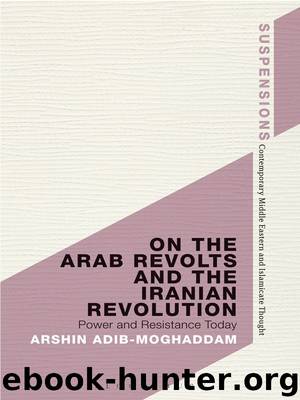On the Arab Revolts and the Iranian Revolution by Adib-Moghaddam Arshin

Author:Adib-Moghaddam, Arshin.
Language: eng
Format: epub
ISBN: 9781472506146
Publisher: Bloomsbury UK
Published: 2013-03-21T16:00:00+00:00
Licentious power versus revolutionary libido
For the revolutionary subject, death is a beginning, justice is transcendental and martyrdom is Erlebnis, an ineffable concession to the cause. The revolutionary subject craves climactic events; it functions according to what I term a ‘libidinous bio-ontology’. The revolutionary subject is adamant to demonstrate political prowess, the ability to channel passion into political action. The revolutionary subject relentlessly tries to elicit as many ‘ineffable’ events as possible in order to establish a superior counter-discourse which would be linked, with the help of an intellectual vanguard, into a strident, ideologically charged counter-culture simulating the viability of a temporal break with everything that ‘is’. This is what Marx called the ‘sixth great power’, which would overwhelm, quite inevitably, every other power in its way. In Labour of Dionysus, Michael Hardt and Antonio Negri allude to this transformative dynamic that drives the revolutionary subject. According to them: ‘It is as if the world is unmade and reconstructed on the basis of a set of thoughts, actions, and intuitions established on the individual and collective singularity that organize it through its desire and its power.’25 This desire and power of the revolutionary subject is organized and infused by the Utopia that everything is possible. Time and being are conceived of as limitless, and the revolutionary subject is placed at the edge of that possibility, with a clear view of what is to come in the future. The revolutionary subject employs a distinctly modern, positivistic syntax that is almost impervious to disappointment and taking as its primary battle ground the official writing of history and the national narratives thus spun.
Charles Kurzman has recently termed the revolution in Iran ‘unthinkable’, a coincidence of several factors that were unpredictable and that delivered the revolution almost as a bonne chance of history.26 However, Kurzman does not take into account that Iranians began to ‘think’ the revolution at least since the late 1950s. Indeed, in the most influential writings of Iran’s prototypical revolutionary intellectuals, such as Jalal Al-e Ahmad and Ali Shariati, Iranian history in particular and Islam in general were rewritten to function as building blocks for a viable and uncompromising ideology that was quite overtly and explicitly revolutionary. So for the former, the thirteenth-century astronomer and philosopher Nasir ad-Din Tusi (1201–1274) becomes the prototypical ‘aggressive intellectual’ (rowshanfekr-e mohajem), ‘who made history’ after obliterating the prevalent order seeking to ‘destroy the contemporary governmental institutions in order to erect something better in their place’.27 For the latter, we find a comparable signification of revolutionary change which is likened to a golden age of justice, a classless society, social equality, and the final victory of the oppressed masses against their oppressors. According to Shariati, there was no choice toward that end since the victory of the revolution was historically determined. This would make it mandatory for the vanguard to ‘object to the status quo and to negate the ruling systems and values’.28 With Al-e Ahmad and Shariati, then, an entirely new ontology for Iran is imagined and increasingly enacted.
Download
This site does not store any files on its server. We only index and link to content provided by other sites. Please contact the content providers to delete copyright contents if any and email us, we'll remove relevant links or contents immediately.
American Kingpin by Nick Bilton(3510)
Future Crimes by Marc Goodman(3374)
The Meaning of the Library by unknow(2386)
Inside the Middle East by Avi Melamed(2233)
Why Nations Fail: The Origins of Power, Prosperity, and Poverty by Daron Acemoglu & James Robinson(2176)
On Tyranny by Timothy Snyder(2127)
Living Silence in Burma by Christina Fink(1981)
Putin's Labyrinth(1902)
The Mastermind by Evan Ratliff(1830)
The Smartest Kids in the World by Amanda Ripley(1686)
Think Like a Rocket Scientist by Ozan Varol(1677)
Law: A Very Short Introduction by Raymond Wacks(1636)
It's Our Turn to Eat by Michela Wrong(1593)
The Rule of Law by Bingham Tom(1592)
Leadership by Doris Kearns Goodwin(1563)
Philosophy of law a very short introduction by Raymond Wacks(1542)
A Dirty War by Anna Politkovskaya(1542)
Social Media Law in a Nutshell by Ryan Garcia & Thaddeus A Hoffmeister(1451)
Civil Procedure (Aspen Casebooks) by Stephen C. Yeazell(1440)
